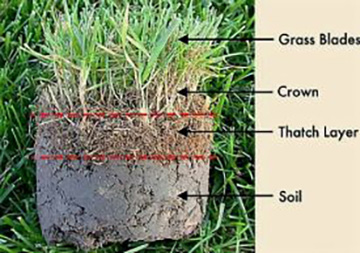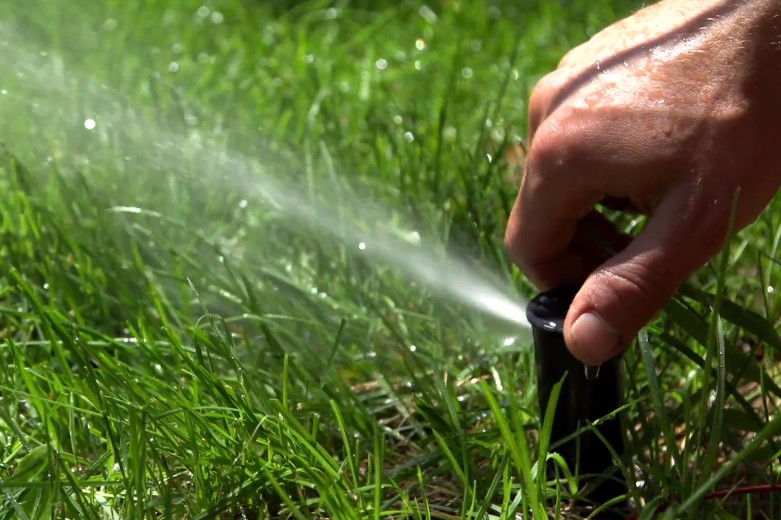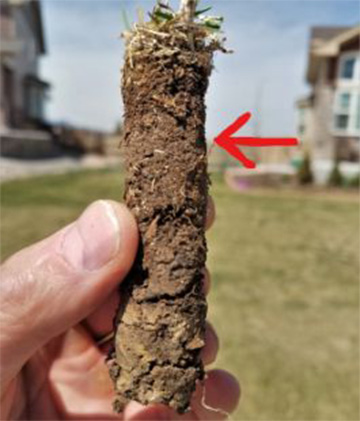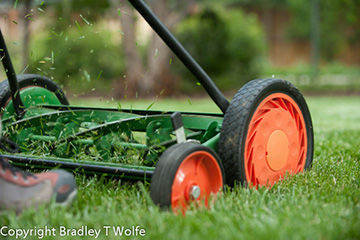WHAT CAUSES LAWN THATCH ACCUMULATION?
What Causes Thatch to Buildup in a Lawn?
Improper Lawn Care Cultural Practices That Kill Microbes
Thatch will accumulate in a lawn if the production of dead material (organic matter) exceeds the ability of the microorganisms in the soil to break down the organic matter. Thatch build-up occurs in lawns that have “dead soils” and thatch is a symptom of the absence of beneficial microbial activity. Thatch buildup happens if there is poor soil aeration and drainage. Improper lawn watering practices (usually too much water or too frequent water), cold soil temperatures, the use of chemical pesticides, and the use of synthetic fertilizers are all factors that increase thatch accumulation in lawns.
When a lawn’s thatch layer is greater than 3/4 of an inch thick it may need to be mechanically removed via power raking or vertical cutting.
Lawn Care Practices That Cause Thatch Buildup in Lawns
- Shallow or frequent lawn watering practices.
- Severe over watering of the lawn.
- Fertilizing the lawn with fast release nitrogen. Salt based nitrogen like those found in synthetic fertilizer sources will kill microbes in the soil.
- Mowing the lawn infrequently where more than 1/3 of the blade of grass is removed.
- The use of lawn herbicides and lawn fungicides. Both of these have been proven to kill microbial activity in soils.
- Compacted soils that have not been aerated annually.

Thatch that is 1/2 inch or less is considered normal. More than 3/4 inch of thatch can be a major problem for the lawn.
What is Lawn Thatch?
Lawn thatch is composed of a tightly intermingled layer of stems, leaves and grass roots, which accumulates between the vegetation and the soil. Too much thatch increases the turf’s susceptibility to lawn diseases, reduces its tolerance to drought, cold, and heat stress; and hinders the movement of air, water, fertilizers, and nutrients into the soil. In severe cases roots of the grass will not grow into the soil but only take root in the thatch layer making the turf susceptible to drought and heat stress.
Why Do Most Lawns Not Need Mechanical Thatch Removal?
If a lawn is building thatch faster than the microbes can break it down, this indicates that the lawn is lacking beneficial microbes. The cure to a thatch problem is not physical removal of the thatch, but by managing thatch in a lawn by stopping the improper cultural practices that are killing microbes in the soil. The cure to preventing and curing a thatch problem isn’t mechanical removal of the dead grass, instead it is to stimulate beneficial microbial activity in the soil.
99.99%+ of lawns DO NOT need to have the thatch removed via power raking or vertical cutting. Please contact your local lawn care expert before scheduling or performing a power rake service.

Lawn aeration is an excellent way to stimulate beneficial microbial activity in soils. Air is vital to soil health and aeration should be perfromed at lease once per season.
Steps to Repair a Thatch Problem in a Lawn
How To Manage Thatch Buildup in a Lawn
Start by stimulating beneficial microbial activity by implementing proper lawn watering practices, lawn mowing practices, core aeration and lawn fertilization.
Power raking is a tool that can be used as a last resort to manage a major thatch problem, but power raking is not the cure of the thatch problem. Power raking or vertical cutting is only recommended in the most severe cases of thatch and only when performed prior to the lawn coming out of dormancy.
Power Rake, but only if it is before the lawn has greened-up in the spring. This lawn care service is rarely necessary
Double Aeration to bring air into the soil.
Sprinkler Audit to fix any improper lawn watering practices. Make sure to follow the principles of the 1-2-3-2-1 lawn watering technique.
Stop all fast release nitrogen, synthetic fertilizer, herbicide or fungicide applications.
Apply Synergy with Corn Gluten Meal and Humate Soil Conditioner to stimulate beneficial microbial activity.

Following the 1-2-3-2-1 lawn watering technique is the best way to reduce thatch buildup.
A Foolproof Guide to Thatch in a Lawn
Some lawn thatch is good! ½ of an inch or less is a normal amount of thatch.
- Thatch buildup occurs when the microbes in the soil cannot break down the organic matter as fast as it accumulates. This typically only occurs when there is a lack of microbial activity in the soil.
- Excessive thatch is caused by the absence of beneficial microbial activity.
- Excessive thatch is often caused by improper watering practices; usually too much or too frequent lawn watering.
- If the thatch layer is greater than ¾ of an inch then power raking is a tool that can be used to help manage the thatch. We only recommend power raking a lawn if the grass is still dormant and only in severe thatch problem lawns.
- Power raking should never be performed after the lawn greens-up. This can cause severe damage to a lawn. Typically power raking is performed in early March.
- Fast release nitrogen sources (non-organic fertilizers) can stimulate thatch buildup.
- Aeration or double aeration are excellent for stimulating air movement in soils and will help prevent thatch buildup in lawns.

This core sample shows a thatch layer of 1 inch. This lawn is suffering from a severe thatch problem that was caused by improper watering and fertilization practices.
A Foolproof Guide to Thatch in a Lawn
Some lawn thatch is good! ½ of an inch or less is a normal amount of thatch.
- Thatch buildup occurs when the microbes in the soil cannot break down the organic matter as fast as it accumulates. This typically only occurs when there is a lack of microbial activity in the soil.
- Excessive thatch is caused by the absence of beneficial microbial activity.
- Excessive thatch is often caused by improper watering practices; usually too much or too frequent lawn watering.
- If the thatch layer is greater than ¾ of an inch then power raking is a tool that can be used to help manage the thatch. We only recommend power raking a lawn if the grass is still dormant and only in severe thatch problem lawns.
- Power raking should never be performed after the lawn greens-up. This can cause severe damage to a lawn. Typically power raking is performed in early March.
- Fast release nitrogen sources (non-organic fertilizers) can stimulate thatch buildup.
- Aeration or double aeration are excellent for stimulating air movement in soils and will help prevent thatch buildup in lawns.

Thatch does not accumulate in a lawn from mulching grass clippings. Thatch accumulates from the lack of microorganism activity and buildup of organic matter due to the absence of a living soil.
FAQ – Symptoms of Under Watering a Lawn
How to water a lawn with clay soil?
Proper lawn watering using the 1-2-3-2-1 lawn watering technique is the best way to water a lawn with clay soils because it will help prevent soil compaction. The best way to improve a clay soil is to create an environment that is teaming with microbes, a.k.a. a living soil.
A wonderful organic lawn care products that is designed to bust up clay soils is Humate soil conditioner. Humate is scientifically proven to stimulate microbial activity in the soil. Lawn aeration is also an important lawn care service that will help alleviate soil compaction and break up the heavy clay content of soils.
How much water does a lawn need to stay green?
Grass requires different amounts of water depending on how much sun the lawn receives. For instance, a south facing lawn in full sun will require .6”-.7” of water, a normal facing aspect with partial sun will require .5”-.6” of water, and a north facing aspect or lawns in full shade will require .4”-.5” of water per watering.
Every sprinkler system is different and the output of each sprinkler zone on an irrigation system is different too. The best way to determine how long to water a lawn is to get an accurate measurement of each zone in a sprinkler system. Using a rain gauge or a flat-bottomed flat-sided container is the best way to get an accurate measurement.